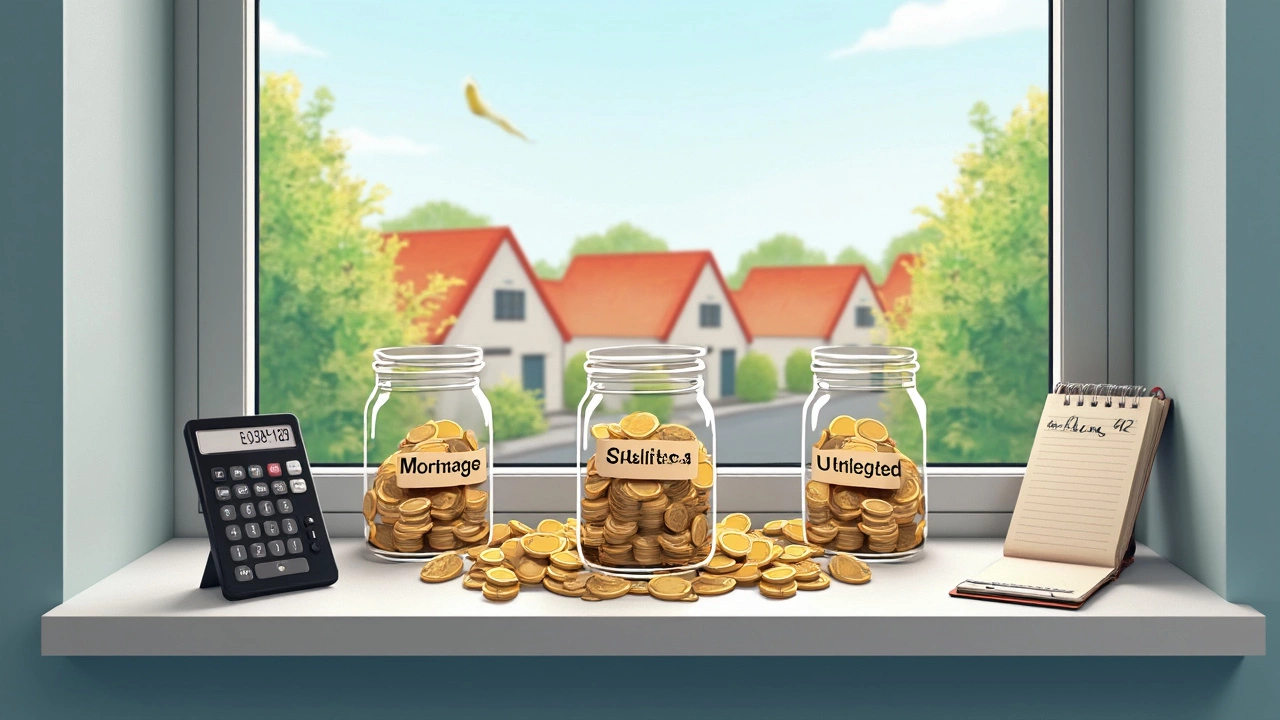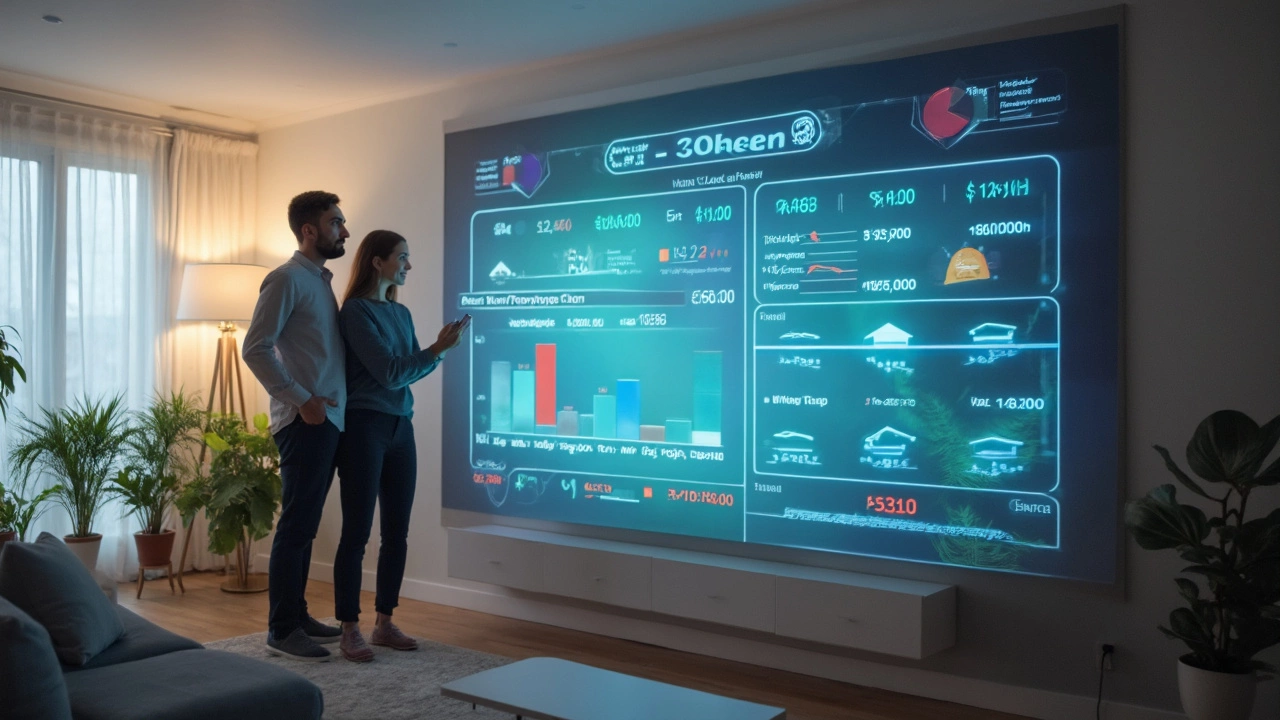$150,000 Mortgage Monthly Payments: Real Costs, Examples & Saving Tips
 Jun, 27 2025
Jun, 27 2025
Crack open any financial forum and you’re bound to see the same question pop up: What’s my monthly payment if I take out a $150,000 mortgage? It sounds simple, but the answer isn’t always straightforward. Some people pay less than their phone bill, others fork over more than they spend on groceries for a family of four. Interested in why that happens and how to make smart decisions? Keep reading.
Mortgage Math: What Really Determines Your Monthly Payment?
Let’s get something clear right away—there’s no one-size-fits-all answer for how much you’ll end up paying each month on a $150,000 home loan. It’s like asking how much it costs to feed a big dog like Maximus—depends on what you feed him, right? It works the same for loans. Your monthly bill changes depending on a handful of tricky variables: interest rate, loan term, down payment, and other sneaky costs like taxes and insurance.
Those fancy online calculators are useful, but if you don’t know your numbers, they’re as helpful as a broken GPS. Let’s start with the core formula. For fixed-rate mortgages—the most common kind—the bank uses the following:
Mortgage Payment (P) = [r(1+r)^n] / [(1+r)^n – 1] * Principal
Where:
- r = monthly interest rate (annual rate ÷ 12)
- n = total number of payments (years × 12)
- Principal = loan amount (that’s your $150,000)
Interest rates shift all the time. For example, in 2024, the average 30-year fixed mortgage wobbled between 6.4% and 7%. Five years ago, that rate was closer to 3-4%. With a 30-year loan at 7%, your monthly payment is a totally different beast than at 5.5%. Don’t forget term length either. A shorter loan means steeper monthly bills but way less interest over the whole life of the loan.
Think of it like a road trip: speed (term), gas mileage (interest), and route (loan amount) all play big roles in how far your wallet takes you. The more you put down upfront—say, a $20k or $30k down payment—the less you owe, so your monthly payment shrinks.
Crunching Numbers: Real-World Monthly Payments for $150,000 Mortgages
You don’t want guesstimates; you want real numbers. Time to break out the calculator. Here’s a peek at monthly payments for $150k borrowed, using fixed-rate loans as examples. I’ve skipped crazy-low rates from the pandemic because, let’s be honest, nobody’s getting 2.5% these days:
| Interest Rate | Term (Years) | Monthly Payment (Principal + Interest only) | Total Interest Paid Over Term |
|---|---|---|---|
| 7% | 30 | $997 | $209,456 |
| 6.5% | 30 | $948 | $191,346 |
| 6% | 30 | $899 | $173,757 |
| 7% | 15 | $1,348 | $92,677 |
| 6.5% | 15 | $1,307 | $85,273 |
| 6% | 15 | $1,266 | $77,882 |
Big difference, right? Just a one percent change in rate could mean $100 less or more out of your pocket each month. And look at those 15-year options—the payment’s higher, but you save over $100,000 in interest.
Oh, and none of this counts taxes and insurance. Most lenders want you to escrow those payments, adding maybe $200-$400 per month, depending on your location. In New Jersey, for example, people pay eye-watering property taxes. In Kansas? Not so much.
Got good credit? That helps chop down your rate. Less than stellar credit? You could pay hundreds more per year. And don’t forget PMI (private mortgage insurance) if you put down less than 20%. That’s another $50 to $150 monthly—money most folks would rather spend on Netflix, or, y’know, dog treats for Maximus.

Beyond the Basics: Taxes, Insurance, and Other Costs No One Warns You About
Let’s talk about the stuff that often blindsides first-time buyers. Your “mortgage payment” doesn’t always stop at just principal and interest. A $997 monthly payment on a $150k mortgage (at 7%, 30 years) is only part of the story. Here’s what usually joins the party in your monthly bill:
- Property Taxes: These can be wild. In 2023, the U.S. average was roughly 1.1% of home value per year. On a $200,000 house (say your place appreciated), you’d pay $2,200, or $183/month. If you live in Texas or Illinois, brace for much more.
- Homeowner’s Insurance: Necessary, and usually required by the bank. Most Americans pay between $1,000 and $1,500 a year, so say $100/month.
- PMI (Private Mortgage Insurance): If your down payment is less than 20%, this could run $50-$150 monthly. The good news? Once your home equity goes above 20%, you can ask the bank to drop it.
- HOA Fees: In condos, or some single-family homes, expect $200 to $500 a month extra. It pays for things like pools, trash pickup, snow removal—or sometimes nothing at all but you’re still stuck paying.
Stack all that up and your $997 “mortgage” could jump to $1,350 or even $1,700 a month—closer to what a lot of renters are paying in big metro areas. And don’t even get me started on surprise maintenance costs. Two months after moving in, Serena and I had to cough up $800 for a new water heater—because of course, it blew during a winter cold snap when Maximus kept tracking snow inside.
Many homeowners underestimate these real costs. It pays to budget another 1% of your home price per year for repairs and upkeep. On a $150,000 house, that’s $1,500 per year—skip that, and your beautiful kitchen could turn into a fixer-upper overnight.
How to Lower Your Monthly Mortgage Payment on a $150,000 Loan
If your brain’s spinning after seeing those tables and extra fees, here’s the good news: you have way more power to lower your mortgage than you think. No, you can’t talk a bank down the way you’d haggle at a flea market, but you can still work the system.
- Boost your down payment: The best hack is old fashioned—put more money down. Aim for 20% or more. Not only does this cut your principal (lowering your monthly payment), but it often means you can ditch PMI entirely. Borrowing $120,000 instead of $150,000 drops your payment by nearly $200/month and nukes unnecessary fees.
- Shop interest rates: Lenders can vary by up to half a percentage point or more. One study found the difference between top and bottom quotes on a standard mortgage was 0.5%. On $150k over 30 years, that’s $15,000+ in savings. Get quotes from banks, credit unions, and online companies—even the big dogs like Rocket Mortgage and Chase can’t always compete with local lenders.
- Consider a shorter term if you can swing the payment: Fifteen-year loans cost more monthly, but they slash interest. If future-you might want to save tens of thousands, this is the move.
- Keep your credit score healthy: Anything over 740 usually qualifies you for prime rates. If you’re in the low 600s or below, fix your credit first before applying—raise your score, and you could save hundreds monthly.
- Eliminate other debts first: Your debt-to-income ratio matters as much as your credit score. Pay down credit cards or car loans, and lenders will be happier to offer you a good deal—and you’ll feel a lot less stressed.
One pro tip that Serena and I used: make an extra payment a year. Just one full extra principal payment yearly knocks years off the loan and saves you thousands in interest.

Smart Mortgage Moves: Calculators and Long-Term Planning You Can Actually Use
If you want to run numbers yourself, grab a mortgage calculator. Don’t worry, you don’t have to love spreadsheets to find a good one—sites like Bankrate and NerdWallet let you plug in your loan amount, rate, tax estimates, and insurance for a quick snapshot. Play around with down payments and see the impact. It’s weirdly satisfying.
Here’s a 2025 scenario to try: Suppose you borrow $150,000 at 6.5% over 30 years. You put down 10% so you’re paying PMI. Taxes are 1.2% of home value; insurance is $120 a month. What do you get?
- Principal & Interest: $948/month
- Property Taxes: $150/month
- Homeowner’s Insurance: $120/month
- PMI: $85/month
That’s $1,303—before garbage, water, cable, or any emergencies. Once you factor in a maintenance fund, maybe $125 per month, you’re at $1,428. The key? Always look at the full monthly nut, not just the headline mortgage number.
If you’re looking to future-proof your finances, focus on paying down principal when you get a windfall. Some people buy houses planning to refinance after a few years hoping rates will drop. Just remember, refinancing isn’t free—lenders charge several thousand in closing costs even when just rearranging a loan.
And don’t skip over reviewing your mortgage statement once in a while. Some folks discover errors or missed drops in PMI that add up over time. It pays to stay a little obsessive, because banks don’t call you up to offer better rates or cut bills—they’re just happy collecting payments.
Ready to move forward? Remember to shop around, get everything in writing, and triple check the numbers before signing on the dotted line. The real monthly payment on a $150,000 mortgage is never just one simple number—it’s a combination of smart preparation, careful planning, and knowing the system better than most. Don’t just settle for what the bank tells you up front—you could save more than you think.
